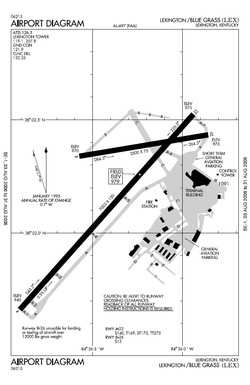But Carrier Insists There's Plenty of Blame To Go Around
Comair officials have admitted two of their pilots were
partially at fault for an August 27, 2006 crash that killed 49 of
50 people on board... but blame does not solely rest with those in
the flight deck of the doomed CRJ100, the carrier insists.

According to the NTSB, Comair flight 5191, a Bombardier
CL-600-2B19 (CRJ-100), N431CA, crashed during takeoff from Blue
Grass Airport (LEX) in Lexington, KY. The airplane, which had been
cleared for runway 22, taxied onto runway 26 instead and ran off
the end of that shorter runway. Of the 47 passengers and 3
crewmembers on board the airplane, 49 were killed; the co-pilot
received serious injuries.
Comair, a wholly owned subsidiary of Delta Air Lines, contends
better systems for alerting airlines to taxiway changes may have
prevented the fatal takeoff crash.
The airline wrote in a submission to the NTSB how the current
system was "developed in the era of the teletype" and was woefully
out of date... adding such information should be available to
pilots in "real time." Comair also complained the FAA needed "a
better approach to runway surveillance. Only one controller was on
duty at the time, and if there had been more, the accident might
have been prevented."
Blue Grass Airport officials, planemaker Bombardier and the
National Air Traffic Controllers Association lay the bulk of the
blame on the pilot and co-pilot, according to the Associated Press.
The co-pilot, James Polehinke, was the only survivor.
 Comair contends there
is plenty of blame to go around.
Comair contends there
is plenty of blame to go around.
"It would be simple but inaccurate to conclude that the only
cause of this tragic accident was a mistake by Comair's well
trained and experienced flight crew," the airline said in its NTSB
submission.
Blue Grass Airport places full blame squarely on the pilots.
"The probable cause of the crash of 5191 are directly related to
the performance of the Captain and First Officer," the airport
states, adding a "loss of situational and location awareness"
led Capt. Jeffrey Clay to mistakenly taxi the airplane onto the
shorter Runway 26 instead of main Runway 22."
LEX officials stated further, "this was due to the
unprofessional manner in which the flight crew performed their
required duties after starting the airplane and during taxi for
takeoff" and "the engagement in continuous non-essential and
distracting conversation ... ," according to the Lexington
Herald-Leader.
 Transcripts of
previously released cockpit voice recordings showed Clay and
Polehinke discussing jobs, dogs and children while waiting for take
off clearance.
Transcripts of
previously released cockpit voice recordings showed Clay and
Polehinke discussing jobs, dogs and children while waiting for take
off clearance.
Comair says it places "strong emphasis" on safety and adds the
FAA should change the current system used to notify pilots of
runway changes.
LEX asserts all its taxiways, markings, lights and signage "were
proper and in compliance" with FAA regulations, a claim disputed by
the Air Line Pilots Association. ALPA contends Flight 5191's pilots
"confronted misleading taxiway signage and lighting cues that led
them to believe that they were approaching runway 22; their
intended runway."
In the days prior to the crash, the taxiways at LEX had been
"slightly altered" due to a renovation. There was a NOTAM released
alerting pilots to the widening and repaving project.
"During the course of this investigation, numerous system and
safety deficiencies were identified as well as a significant number
of human performance issues on the part of both the flight crew and
the controller on duty at the time; all of which played a major
role in this accident," the union said.
The National Air Traffic Controllers Association accused the FAA
for breaking its own rules in allowing a single controller to man
the tower.
"Had there been two controllers in the tower, as required,
NATCA's position is that this accident would not have happened,"
the union said in its NTSB submission.
The FAA has acknowledged that more than one controller should
have been watching the ground and the air the night of the
accident.
LEX has hired former NTSB managing director Peter Goelz as a
consultant. He said the submissions "raise some important issues"
but the crash "still boils down to pilot error."
"This is a painful accident because it is so heavily focused on
human performance failures. ... It's a terrible thing to have to
say that," Goelz said.
He believes the cockpit transcript indicated the pilots "were
completely unaware of their mistakes even when they should have
been."
"You cannot underestimate the amount of distraction ... They
were not paying attention," Goelz said.
 Airborne-NextGen 11.04.25: Anduril YFQ-44A, Merlin SOI 2, UAV Rulemaking Stalled
Airborne-NextGen 11.04.25: Anduril YFQ-44A, Merlin SOI 2, UAV Rulemaking Stalled NTSB Prelim: Elmore Travis C Searey
NTSB Prelim: Elmore Travis C Searey ANN's Daily Aero-Linx (11.03.25)
ANN's Daily Aero-Linx (11.03.25) ANN's Daily Aero-Term (11.03.25): On-Course Indication
ANN's Daily Aero-Term (11.03.25): On-Course Indication Aero-News: Quote of the Day (11.03.25)
Aero-News: Quote of the Day (11.03.25)




